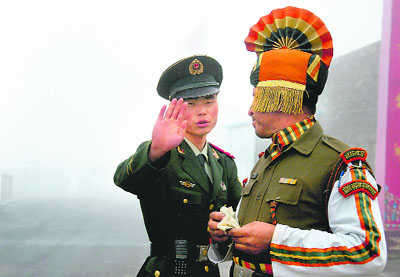
Sandeep Dikshit
Tribune News Service
Beijing, August 7
China has assumed an air of perplexity over the border standoff by claiming there should have been “other reasons” for the “ingress” by Indian troops in Doklam because it had twice notified the South Block about its intention to build a road, but received no response.China claims it first notified India of its intention to build a road on March 18, a day after an Indian military delegation visited the 3rd Garrison Division of the People’s Liberation Army on the outskirts of Beijing, as a goodwill gesture. It again told India a fortnight before PLA troops arrived with bulldozers, but did not get a reply from the Indian side, Senior Colonel of the PLA Ren Guo Qiang told a select group of Indian journalists here today. It is rare for the PLA to host Indian journalists at a time when it is confronting Indian troops.(Follow The Tribune on Facebook; and Twitter @thetribunechd)Senior Colonel Ren as well as his counterpart at the 3rd Garrison Division were firm in their demand that India must unilaterally pull out its troops while refusing to acknowledge that the site of the standoff was a disputed territory and hence required talks to sort out the issue.The burden of the Chinese argument is that India should not have jumped into the fray when the party complaining about a developing security headache should be Bhutan. The Chinese officials dismissed the concerns raised by Bhutan’s Parliament and a statement by its Foreign Office as an outcome of arm-twisting by India.Asked why China notified India about its intention to construct the road when it claims the matter is between Thimphu and Beijing, Senior Colonel Ren said this was done out of a gesture of goodwill.They were also unwilling to accept that India’s security concerns could have dictated the standoff when both sides arrived at the same spot with bulldozers and armed soldiers. India is unwilling to let the Chinese build a road up to a ridge that overlooks, just like Kargil, a vulnerable corridor connecting the mainland of the country to its North-East.The Chinese military officers emphasised the seriousness of the current standoff as compared to the earlier ones in Demchok and Chumar, both in the eastern sector of Ladakh.In the earlier cases, cartographic confusion had led to the confrontation between the two armies. In this case, Tibet’s border with Sikkim, from where the Indian troops descended to confront the Chinese, was delineated by a 1890 treaty that had held for 127 years.Dismissing India’s argument that it was trying to safeguard its own and Bhutan’s security, the Chinese want to ask why Indian troops crossed a boundary whose sanctity had been observed for over a century.The officers also reiterated the earlier statements from the Chinese foreign and defence ministries that talked of its army’s resolve to undo the “territorial violation of its territory”. But they dismissed the shrill pitch by their strategic experts and online sites and pointed out that it is the official statements that count.


